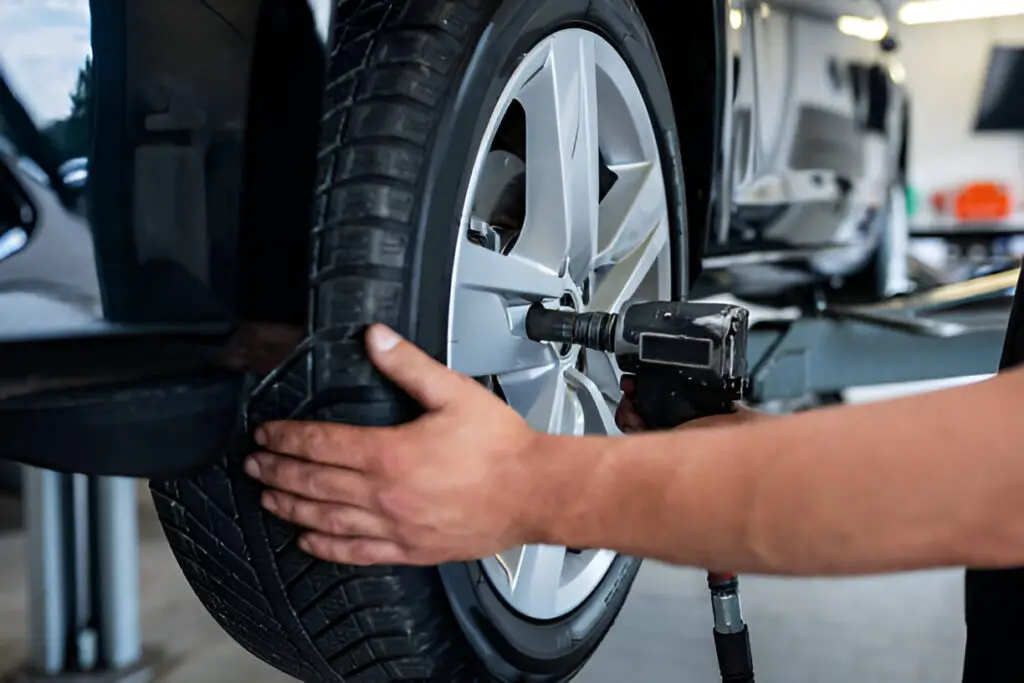Tires should generally be rotated every 5,000 to 7,500 miles to ensure even wear and extend their lifespan. This interval may vary depending on driving habits, vehicle type, and tire condition.
Tire rotation is a crucial part of vehicle maintenance that helps to extend the life of your tires, improve performance, and ensure safe driving conditions. Many drivers overlook or delay tire rotation, which can lead to uneven wear, reduced fuel efficiency, and even increased risk of tire failure. One of the most common questions car owners have is: “How many miles should I go before rotating my tires?”
In this blog post, we’ll explore the importance of tire rotation, when to perform it, and other related factors, including how your driving habits and vehicle type might affect your tire rotation schedule.
Contents
What Is Tire Rotation?
Tire rotation is the practice of moving the tires from one position on the vehicle to another. This is done to ensure that the tires wear evenly across all four positions, as different parts of the vehicle experience varying levels of pressure and weight distribution.
Common Rotation Patterns:
- Front-to-Rear: The front tires are swapped with the rear tires.
- Cross Rotation: Tires are moved diagonally, meaning the front left goes to the rear right, and the front right goes to the rear left.
- Side-to-Side Rotation: The tires on the left side are swapped with those on the right side.
Rotating tires regularly is essential because tires wear differently depending on their position on the vehicle. For instance, on front-wheel-drive vehicles, the front tires bear more weight and handle more tasks like steering, braking, and accelerating, leading to faster wear compared to the rear tires.
How Many Miles Before Tire Rotation?
The general recommendation for tire rotation is every 5,000 to 7,500 miles. However, this interval can vary based on several factors, such as your vehicle type, driving habits, and the type of tires you use.
1. Manufacturer Recommendations
Many car manufacturers provide a recommended tire rotation schedule in the vehicle’s owner manual. For most vehicles, the guideline is to rotate the tires every 5,000 to 7,500 miles. This interval often aligns with routine oil changes, making it convenient to perform both tasks simultaneously.
2. Driving Conditions and Habits
If you frequently drive in rough conditions, such as off-road, on gravel, or through heavy urban traffic with lots of braking and accelerating, you may need to rotate your tires more frequently. Aggressive driving or regularly carrying heavy loads can also lead to faster tire wear, requiring rotation sooner.
3. Tire Type
- All-Season Tires: Typically need rotation every 5,000 to 7,500 miles, as they’re designed for general driving conditions.
- Performance Tires: These tires may need more frequent rotations due to their softer compounds and focus on grip, which can lead to faster wear.
- Winter Tires: Should be rotated at the start and end of the winter season if they’re used only seasonally.
4. Drive Type
- Front-Wheel Drive (FWD): The front tires wear out more quickly as they handle most of the vehicle’s weight, steering, and braking. Regular rotations are crucial to prevent front tire wear.
- Rear-Wheel Drive (RWD): While the rear tires wear faster in RWD vehicles, the difference between front and rear wear is less pronounced than in FWD cars. Still, rotations should follow the recommended schedule.
- All-Wheel Drive (AWD): In AWD vehicles, all four tires receive power, but wear can still be uneven due to weight distribution. Many AWD vehicle manufacturers recommend tire rotation every 3,000 to 5,000 miles.
Frequently Asked Questions
Here are some FAQs about tire rotation –
1. How often should tires be rotated?
Tires should generally be rotated every 5,000 to 7,500 miles, but it’s best to consult your vehicle’s owner manual for specific recommendations. Factors like driving habits, vehicle type, and tire condition can also affect the rotation schedule.
2. What happens if you don’t rotate your tires?
Failing to rotate the tires can lead to uneven wear, reduced tire lifespan, decreased fuel efficiency, and poor handling. It can also increase the risk of tire failure, which could result in an accident.
3. Can I rotate my tires myself?
Yes, with the right tools and knowledge, you can rotate your tires at home. However, if you’re unfamiliar with the process or lack the necessary equipment, it’s best to have a professional do it to ensure it’s done safely and correctly.
4. Does tire rotation affect alignment?
Tire rotation doesn’t affect the alignment directly, but uneven tire wear from failing to rotate your tires could lead to alignment issues over time. It’s a good idea to check your alignment when you rotate your tires, especially if you’re experiencing handling problems.
5. Is tire rotation necessary for all-wheel drive vehicles?
Yes, even in all-wheel-drive vehicles, tire rotation is necessary. AWD systems distribute power across all four tires, but they can still wear unevenly due to weight distribution and other factors. Regular rotation helps ensure even wear and extends tire life.
Conclusion
Tire rotation is a critical part of vehicle maintenance that ensures even tire wear, enhances performance, and extends the life of your tires. While the general recommendation is to rotate your tires every 5,000 to 7,500 miles, it’s important to consider your driving habits, vehicle type, and the type of tires you have. Staying on top of tire rotations not only saves you money but also keeps your vehicle safe and performing at its best.
